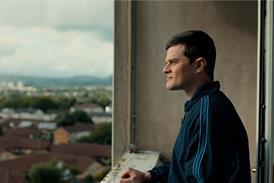Dir/scr/cine: KazuakiKiriya. Japan. 2004. 141mins.
With digital technology,it is now possible to create big, visionary movies without breaking budgets -even those of the Japanese film industry. The result has been a spate ofJapanese films, such as Mamoru Oshii's Innocence, screening incompetition at Cannes, and Katsuhiro Otomo's forthcoming Steam Boy, thattake up where the great megalomaniacs of the silent era left off.
It is Kazuaki Kiriya's retrofuturistic epic Casshern, however, that most closely resembles FritzLang's Metropolis, Abel Gance's Napoleon and DW Griffith's Intolerance,not only in style and concept, but alsoas a folie de grandeur.
A fashion photographer andmusic video director best known in Japan as the husband of pop diva Hikaru Utada,Kiriya may be making his feature debut with Casshern, but he is startingnear the top of the industry in terms of use of budget, tools and staff. Theresult is a madly ambitious, visually stunning film that redefines its genre.
Casshern was shot for only Y600m (sub $10m), mostly on blue and green screen, inaround three months, with six months in post. Usually filmakers try to blend CGcuts into live-action images as seamlessly as possible: Kiriya, however, madethe live-action shots fit the CG-created images.
The result has performedstrongly at the Japanese box office since its April 24 release, taking justover $0.9m from 14 screens in the country's nine key cities.
Overseas interest is alreadyintense - sales at Cannes are likely to be brisk - with fan sites such as Ain'tIt Cool giving the trailer strong buzz and Kiriya reportedly juggling offersfrom Hollywood. But any idea of a Hollywood remake is absurd - one might aswell resurrect Lang to reshoot Metropolis. Better to let Kiriya and histeam make some of the 10 projects he says he has in his computer: new worldsare waiting to be born.
Though Casshern isbased a 1970s TV anime, its set and character designs draw heavily on early20th century sources, from Soviet propaganda posters to Futurist art (Kirya hasalso name-checked George Orwell's 1984). Instead of giving hispast-as-future vision a cartoony, nostalgic spin, Kiriya takes it seriously.There is a power to this world, with its robot armies of thousands marching interrifying lockstep, but a nightmarish beauty as well.
Stylistically,the film also owes more to European features like Luc Besson's The FifthElement or Enki Bilal's recent Immortel (Ad Vitam) than Hollywood -or indeed anything Japanese. Its aesthetic is diametrically opposed tothe'glittery future city' and 'cool mecha' look of recentofferings like recent anime title Appleseed and so much other'traditional' Japanese sci-fi. It will be interesting to see whatforeign anime fans - who tend to be several years behind their Japanesecounterparts in tastes - make of it.
The story, which Kiriyaco-wrote with Shotaro Suga and Dai Sato, has an operatic sweep and grandiositythat makes Intolerance, with its four parallel story lines, a model ofsimplicity by comparison.
Following a ravaging 50-yearwar - the premise, not clearly stated, is that Japan and Germany won aprolonged World War II - the Greater Eastern Federation has wrested control ofthe Eurasian continent. The survivors have rebuilt using Machine Agetechnology, but the long struggle has left them physically and spirituallyspent. Then a genetic scientist, Dr. Azuma (Akira Terao), develops arevolutionary 'neo-cell' treatment for the afflicted, including hiswife Midori (Kanako Higuchi), who has been blinded by a pollution-causeddisease.
When his request forresearch funds is rejected by Health Ministry bureaucrats, he receives backingfrom a high, if dubious, source. Before he can deliver his miracles, however, amishap in the lab gives birth to a new race of mutants, who escape and build anunderground movement. Their leader is Brai (Toshiaki Karasawa), a super-mutantwith a mad vision for a peaceful world.
Meanwhile, Azuma's sonTetsuya (Yusuke Iseya), who joined the army over the objections of his fatherand fiancee Luna (Kumiko Aso), is haunted by memories of battlefield horrors.Is his father, he wonders, right in wanting to save humanity' Where do hisloyalties lie' What is his true identity'
Kiriya and his collaboratorstake the film's B-movie premise - eccentric scientist unleashes mutant hordes!- as their merest starting point. Their real interest lies in, not astonishingthe audience with CG marvels, but seeding its consciousness with a vision sorichly imagined, so deeply grounded that it exists in a universe of its own.
Theacting itself is, as befits overall Casshern's style, rather operatic:closer in tone to the silent classics than the 'dirty realism' of theperformances found in much modern sci-fi.
Prod cos/backers: Shochiku, Progressive Pictures, Electric Ghost, EiseiGekijo, TV Asahi, Takara, Itochu, Tokyo FM
Jap dist/int'l sales: Shochiku
Prods: Toshiaki Wakabayashi,Hideshi Miyajima, Toshiharu Ozawa
Scr: Shotaro Suga, Dai Sato
CG supe: Haruhiko Shono
Visual FX supe: Toshiyuki Kimura
Action scene story board: ShinjiHiguchi
Prod des: Yuji Hayashida
Costumes: Michiko Kitamura
Main cast: Yusuke Iseya, KumikoAso, Toshiaki Karasawa, Akira Terao, Kanako Higuchi















![[Clockwise from top left]: Paul Thomas Anderson, Chloe Zhao, Ryan Coogler, Park Chan-wook](https://d1nslcd7m2225b.cloudfront.net/Pictures/274x183/9/0/0/1467900_writerdirectors_192733.jpg)



No comments yet